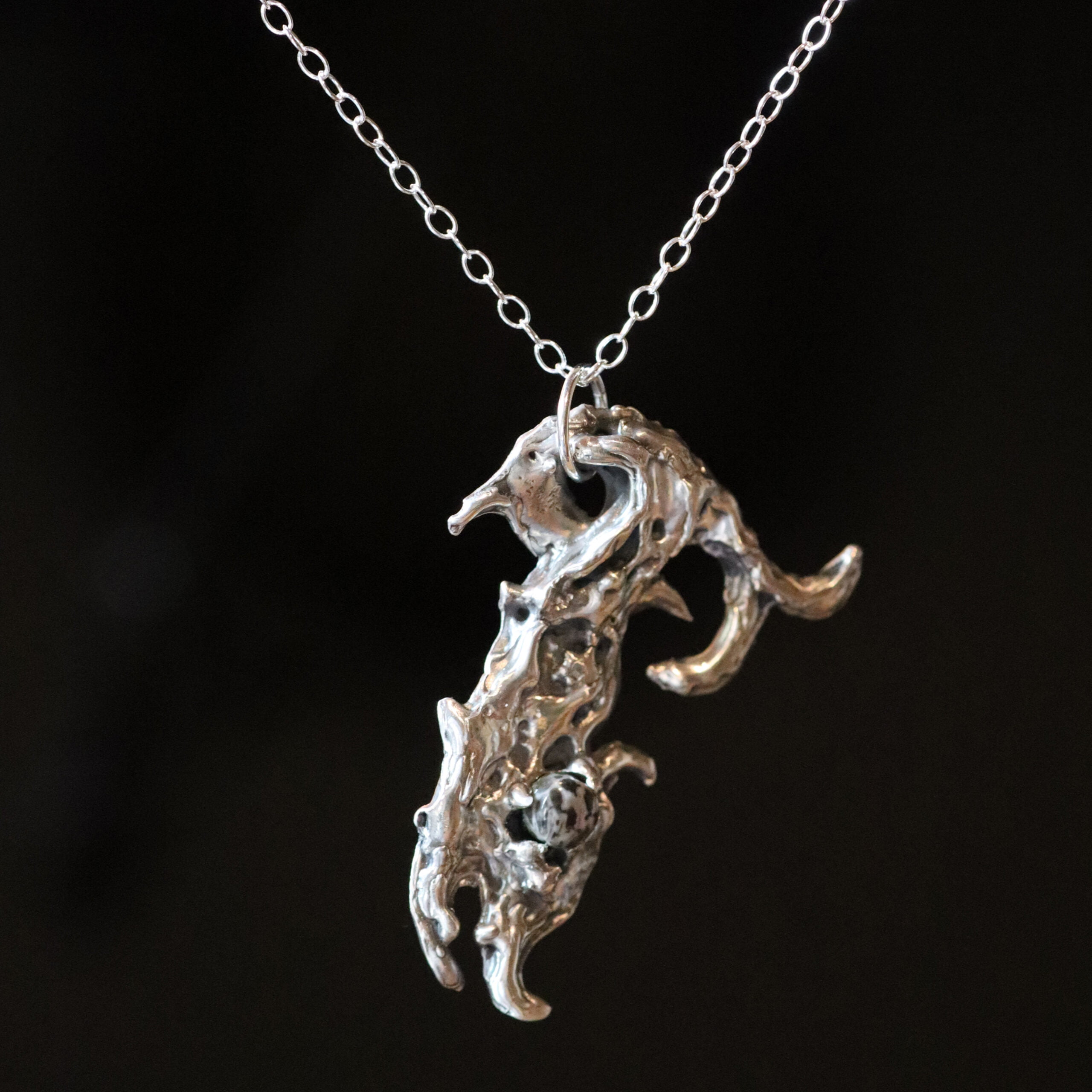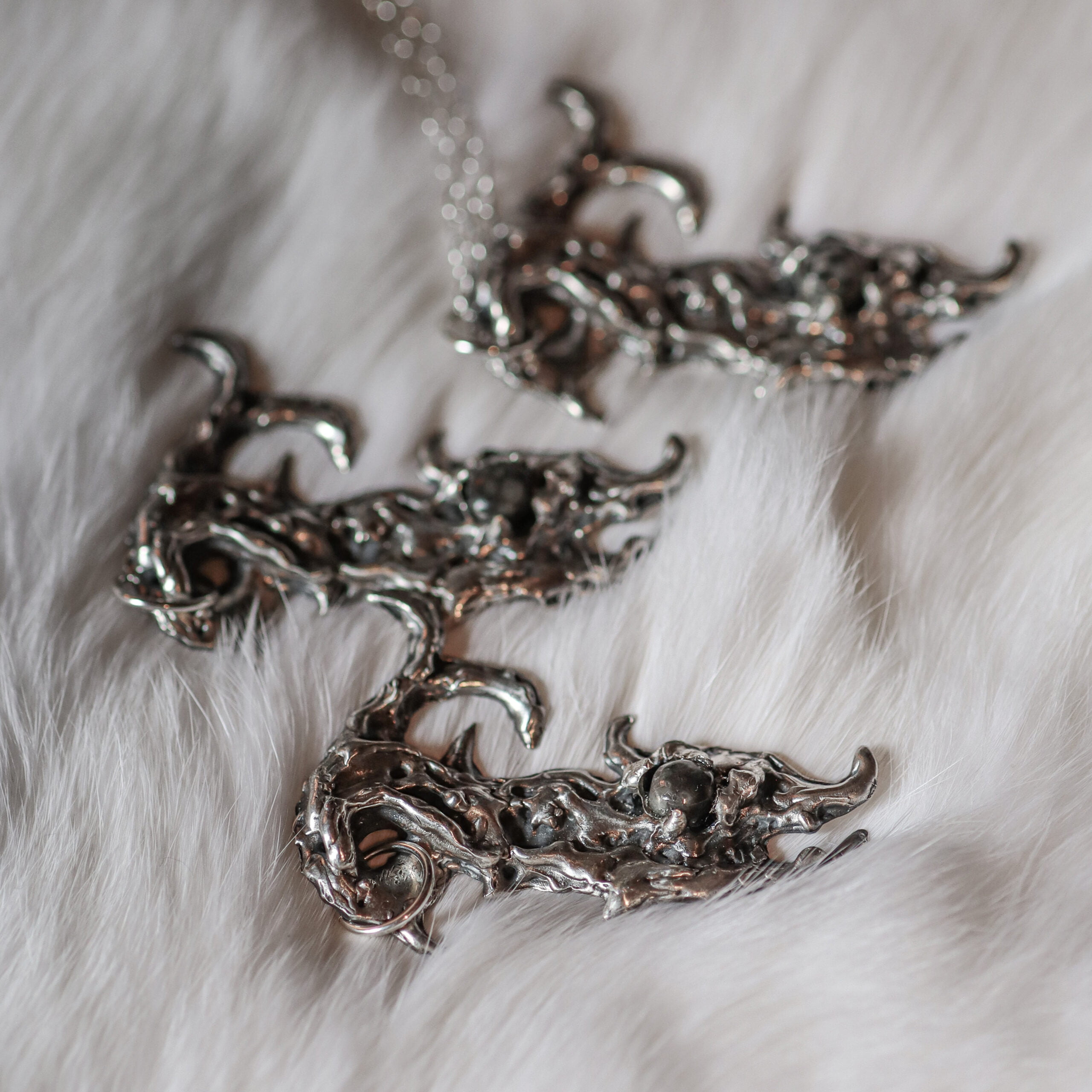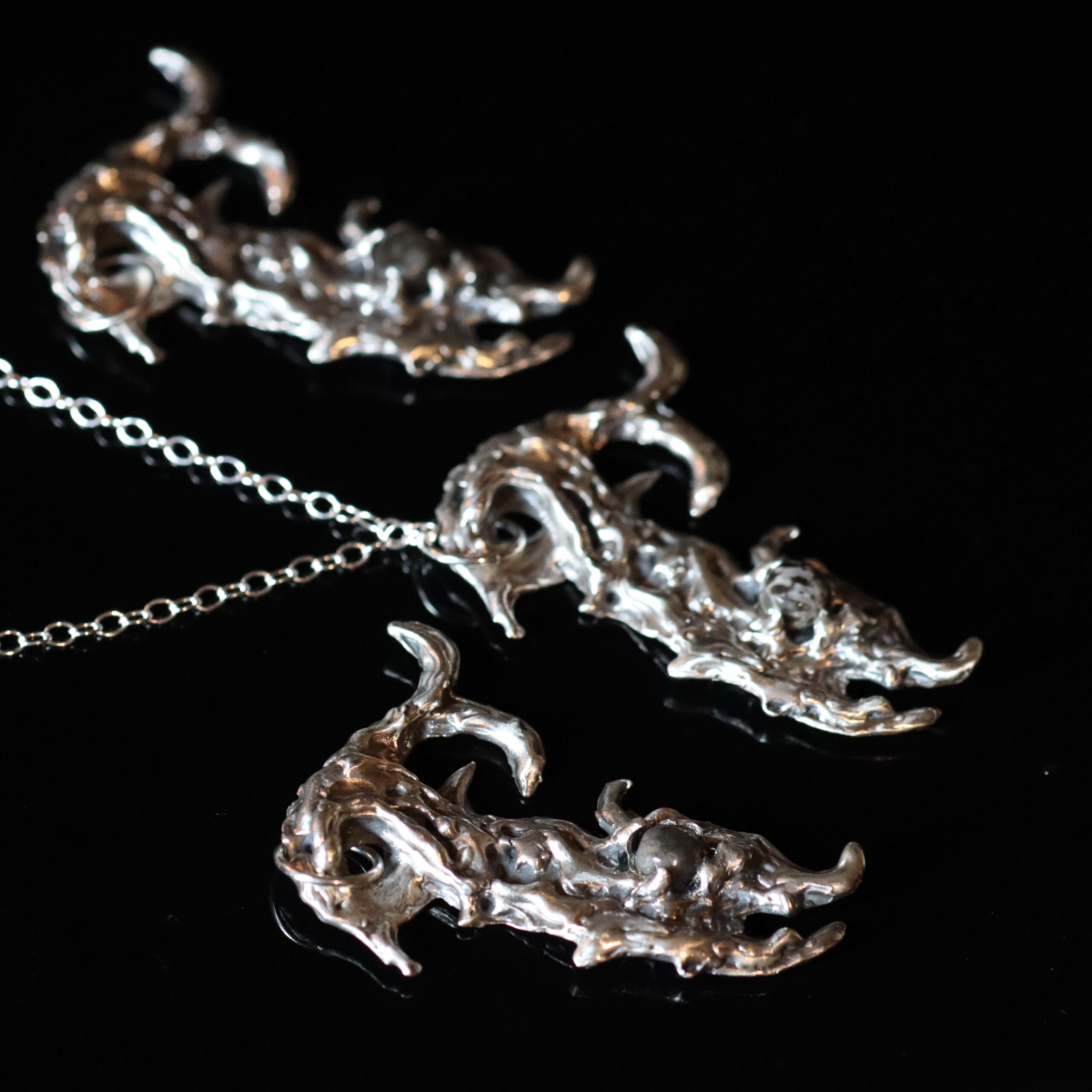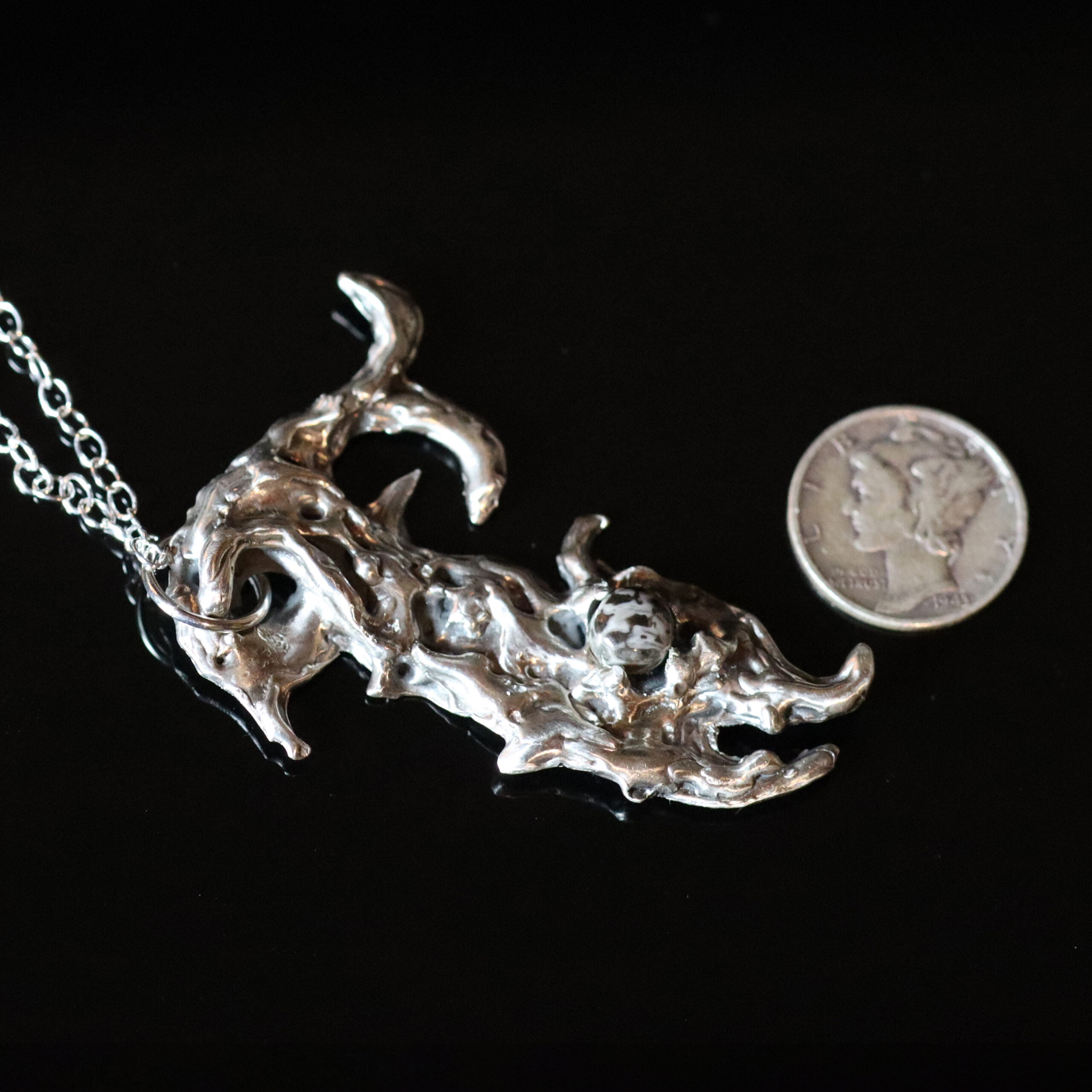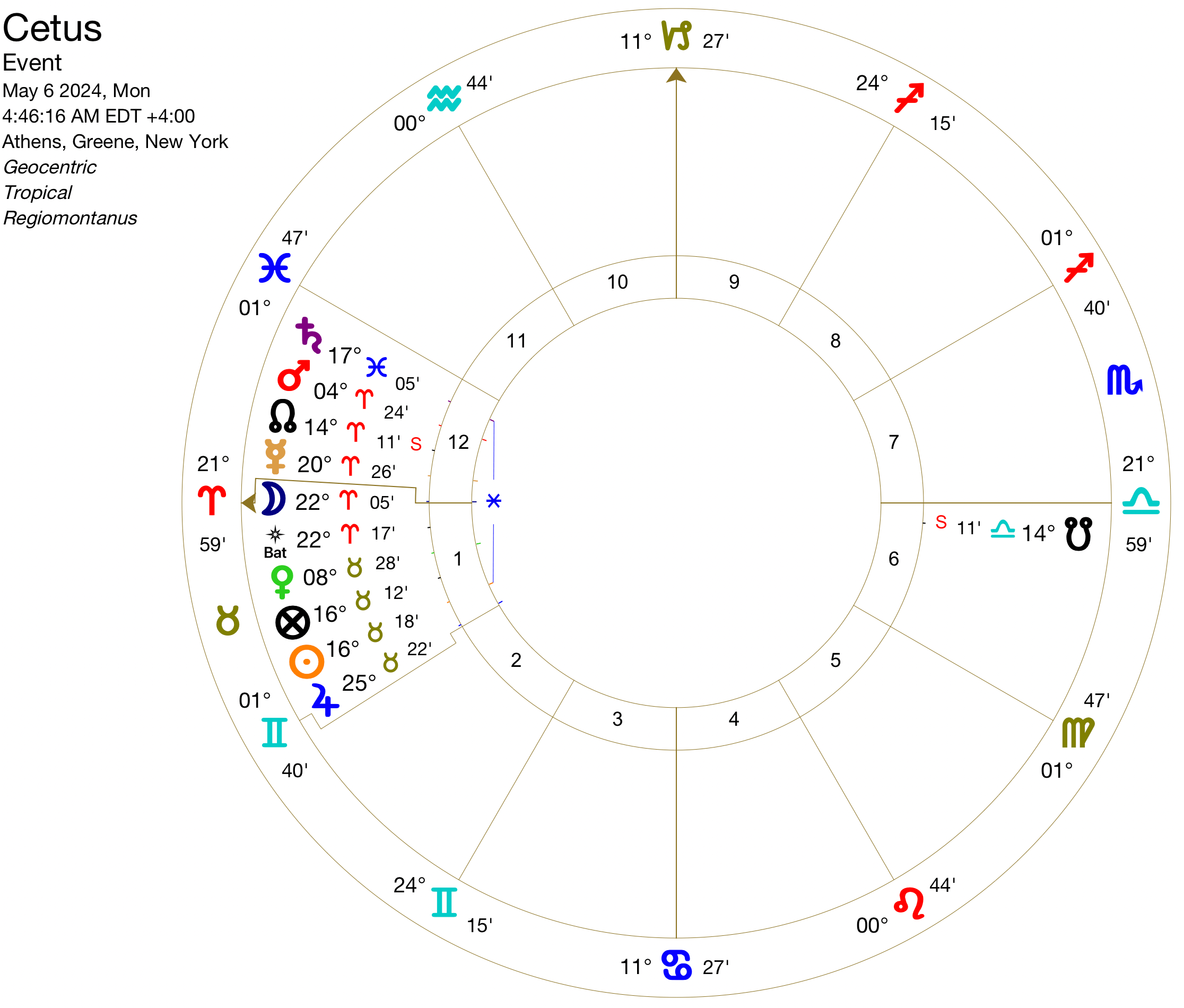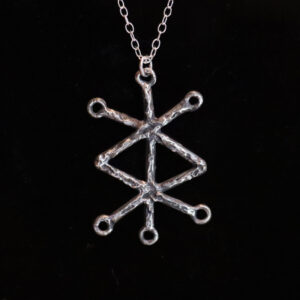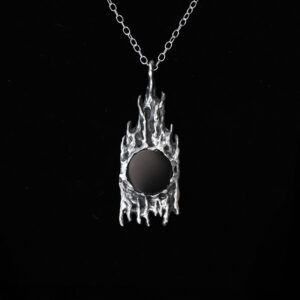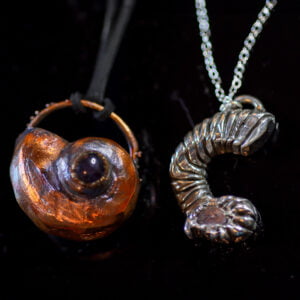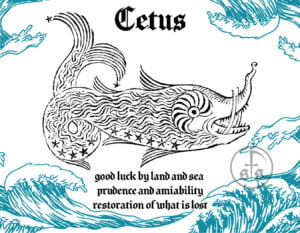
Canst thou draw out leviathan with an hook? or his tongue with a cord which thou lettest down?
Canst thou put an hook into his nose? or bore his jaw through with a thorn?
Will he make many supplications unto thee? will he speak soft words unto thee?
Will he make a covenant with thee? wilt thou take him for a servant for ever?
Wilt thou play with him as with a bird? or wilt thou bind him for thy maidens?
Shall the companions make a banquet of him? shall they part him among the merchants?
Canst thou fill his skin with barbed irons? or his head with fish spears?
-Job 41
Cetus is a large equatorial constellation often referred to as “the whale” or “the sea monster.” Cetus is located in a region of the sky known as The Water, surrounded by other water-associated constellations such as Aquarius, Pisces, and Eridanus. This expansive constellation covers an area of 1,231 square degrees, making it the fourth-largest constellation in the night sky. According to Ptolemy, it is of the nature of Saturn.
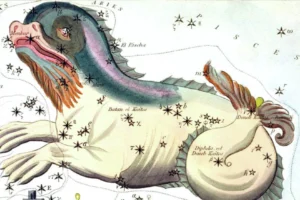 Cetus is best known from Greek mythology, where it appears in the story of Perseus and Andromeda in Ovid’s Metamorphoses. According to myth, Cetus was a fearsome sea monster sent by Poseidon to terrorize the kingdom of Aethiopia. Queen Cassiopeia had boasted that her daughter Andromeda was more beautiful than the Nereids, the sea nymphs, provoking the wrath of Poseidon. To appease the god, Andromeda was chained to a rock as a sacrifice to Cetus. However, Perseus, returning from slaying Medusa, saw Andromeda and rescued her by slaying Cetus with Medusa’s head, turning the monster to stone.
Cetus is best known from Greek mythology, where it appears in the story of Perseus and Andromeda in Ovid’s Metamorphoses. According to myth, Cetus was a fearsome sea monster sent by Poseidon to terrorize the kingdom of Aethiopia. Queen Cassiopeia had boasted that her daughter Andromeda was more beautiful than the Nereids, the sea nymphs, provoking the wrath of Poseidon. To appease the god, Andromeda was chained to a rock as a sacrifice to Cetus. However, Perseus, returning from slaying Medusa, saw Andromeda and rescued her by slaying Cetus with Medusa’s head, turning the monster to stone.
Cetus undulates its scaly back, it rises aloft upon a spiral of coils and splashes with such a belly as drove the sea beyond its proper shores when it appeared from the waves to destroy the daughter of Cepheus exposed upon the cliffs…”
-Manilius, Astronomica
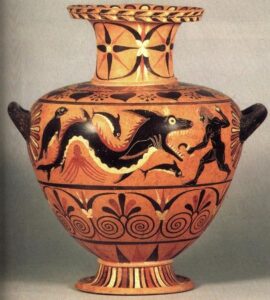
Heracles and the Trojan Sea-Monster, Caeretan black-figure C6th B.C., Stavros S. Niarchos Collection
Cetus is also linked to Tiamat, a chaos monster defeated by the god Marduk in the Enuma Elish creation epic, as discussed by Gavin White in his Babylonian Star Lore. This link remains more speculative, though relevant. Cetus has also been related to the biblical story of Jonah and the whale, as well as the figure of the Leviathan. These creatures are emblematic of the sea’s formidable and chaotic nature, reflecting peoples’ fear and respect for the ocean. They are depicted as massive, serpentine beasts that threaten human life and order, necessitating divine or heroic intervention. In Jewish eschatology, Leviathan, along with Behemoth, is envisioned to play a part in the end-times, where both creatures are destined to be part of a divine feast for the righteous. However in the book, Supernal Serpent, Andei Orlov discusses the role of Leviathan as not simply a sacrificial feast, but as the axis mundi.
William Tyler Olcott in his Star Lore Myths, Legends, and Facts has this to say of Cetus:
Though Aratos and others connect the Whale with the story of Perseus and Andromeda, there is little doubt that the constellation antedates the time of Perseus. In earlier times it seems to have been regarded as some kind of leviathan, without connection with the story of the sacrifice of Andromeda. Allen suggests that it may have represented the ferocious Tiamat of the Chaldean myths. In all delineations it has been a strange and fierce marine creature, unlike any known to man, and totally unlike the figure of a whale.
According to Pliny and Solinus, after the monster’s encounter with Perseus, in which it suffered from the petrifying gaze of the Medusa, its bones were brought to Rome by Scaurus. Saint Jerome corroborated this story, claiming to have seen the bones of the monster at Tyre. Brown tells us that Cetus signified “the chaos of the deep” to the Babylonians. It represented primarily the state of chaos “when the earth was waste and wild and darkness was upon the face of the deep.” Aratos called it “the dusky monster.”
Cetus is sometimes represented as swimming in the river Eridanus, or river Po, the celestial stream into which the venturesome Phaeton was hurled by the bolts of Jove. Burritt depicts the creature with the two front paws immersed in the River, and the constellation lies between this great stream and the flood which pours forth from the jar of the Water Bearer into the gaping mouth of the Southern Fish. Cetus is thus situated appropriately in that region of the sky known to the ancients as “the Sea,” alluded to in a previous chapter, a part of the sky where marine symbols abound.
It has been suggested that these constellations, which might well be designated “the marine group,” arranged here together, might have reference to the rainy season, or a period of flood when the sun was in this region of the heavens.
Brown points out the interesting fact that the southern heavens are generally given over to creatures of ill significance. Here we find Hydra, Scorpius, Lupus, Corvus, Canis Major, and Cetus. Design rather than chance seems evident in this arrangement. In the 17th century Cetus was considered to be a symbol of Jonah’s whale, and also of Job’s leviathan. Dr. Seiss regards it as the old Serpent, which is the Devil and Satan.
Bernadette Brady links Cetus with the unconscious mind and deep emotional currents, paralleling the tumultuous nature of the mythological sea monster. Cetus can represent hidden fears, overwhelming challenges, and the process of confronting and overcoming internal and external adversities. Psychologically, Cetus can indicate facing deep-seated trauma or navigating complex emotional landscapes. It serves as a reminder of the potential for transformation and growth through confronting one’s inner demons. As a great mammalian whale, Cetus straddles two worlds, swimming in the sea while breathing the air of land. There is great medicine in learning to navigate both our own inner and outer landscape, as well as the worlds of matter and spirit. We can view Cetus as the personification of the abyss: a great and terrifying, yet infinitely fertile darkness, which like the sea itself, is filled with myriad sunken treasures and the collective wisdom of the ancestors within it’s watery grave. This is further echoed in the fact that the constellation itself is home to its own memento mori, the Skull Nebula.
Consider the subtleness of the sea; how its most dreaded creatures glide under water, unapparent for the most part, and treacherously hidden beneath the loveliest tints of azure. Consider also the devilish brilliance and beauty of many of its most remorseless tribes, as the dainty embellished shape of many species of sharks. Consider, once more, the universal cannibalism of the sea; all whose creatures prey upon each other, carrying on eternal war since the world began.
Consider all this; and then turn to the green, gentle, and most docile earth; consider them both, the sea and the land; and do you not find a strange analogy to something in yourself?
– Herman Mellville, Moby Dick
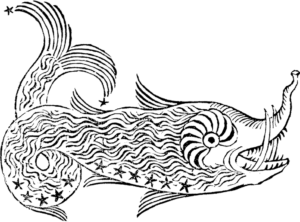 The design for these talismans was based on the pictured woodcut of Cetus from 1482 edition of Hyginus’s Poeticon Astronomicon. The talismans were hand sculpted in jewelers wax and cast in solid sterling silver. The source of the talisman comes from De Mineralibus of Albertus Magnus. “[the Sea Monster or Whale (Cetus)] is found engraved [as a crested serpent having a great hump on its back], and it is said to confer good luck by land and sea, and prudence and amiability, and to restore things that have been lost.” In order to elect a constellational talisman I chose the method as taught to me by Christoper Warnock which involves choosing a central star in the constellation as the focal point so that the entire constellation is either rising or setting during the electional window, and then applying the same electional rules as for electing a fixed star talisman. The star chosen for this election was Baten Kaitos, the belly of the whale, located at 22 degrees Aries. The talismans were created on May 6, 2024.
The design for these talismans was based on the pictured woodcut of Cetus from 1482 edition of Hyginus’s Poeticon Astronomicon. The talismans were hand sculpted in jewelers wax and cast in solid sterling silver. The source of the talisman comes from De Mineralibus of Albertus Magnus. “[the Sea Monster or Whale (Cetus)] is found engraved [as a crested serpent having a great hump on its back], and it is said to confer good luck by land and sea, and prudence and amiability, and to restore things that have been lost.” In order to elect a constellational talisman I chose the method as taught to me by Christoper Warnock which involves choosing a central star in the constellation as the focal point so that the entire constellation is either rising or setting during the electional window, and then applying the same electional rules as for electing a fixed star talisman. The star chosen for this election was Baten Kaitos, the belly of the whale, located at 22 degrees Aries. The talismans were created on May 6, 2024.
I chose a somewhat unconventional factor for this election, a void moon. Athough not usually considered a serious affliction for magical elections (moreso for horary and mundane elections) it is not typically purposely chosen, however it is my personal contention that the void moon is the domain of Cetus. This is a period of time which feels formless, outside of the normal flow of time. It is often uncomfortable and disruptive to our normal activities. It is these periods of discomfort when we “touch the abyss” that are often the most fertile and generative. When we are forced to step outside of routine and well-worn paths. During the electional window, the moon was fast, and waning, which can temper the nature of malefics, and conjoined Baten Kaitos while rising on the ascendant. Because of the more unconventional nature of the election, and the darker associations of the constellation, I chose to balance those factors with an overwhelming presence of benefic influence in the ascendant, which contains Jupiter, domiciled Venus, and the Sun conjoining the Part of Fortune, all fortunating the chart. The chart is available in the product gallery.
Prior to the election the talismans were bathed in seawater which I personally collected mixed with seaweed. During the electional window the fossilized coral eyes were set with seaweed into the talismans which were then ritually inspirited with prayers and invocations and suffumigated with frankincense and more seaweed. 7 talismans were made and each is approximately 2″ long diameter and comes on a 20″ sterling silver chain along with the devotional artwork above printed on card stock. Each contain slight variations due to the talismans being handcrafted and the use of natural stones but will be similar to those pictured and intuitively selected.
In addition to their intended purpose of granting luck by land and see, prudence and amiability, and the restoration of what is lost, on a personal level, my experience of these talismans is that they have a sense of expansiveness to them. They feel “big” and have granted me a sense of wider perspective and space to view and hold my thoughts and troubles. There is a lightness that one experiences when they feel the opposite of trapped or backed into a corner. There is no limit to what the abyss can hold, no burden too great for the belly of a whale.
For the sea is itself nothing but love and emotion. It is the Living Infinite.
― Twenty Thousand Leagues Under the Sea
Here is a playlist of resonant music which aided in their creation and can be used to further connect with their spirit.
May the daimon of these talismans grant you luck by land and sea, prudence and amiability, and restore to you that which has been lost

